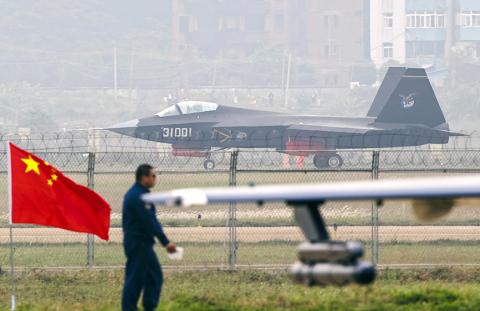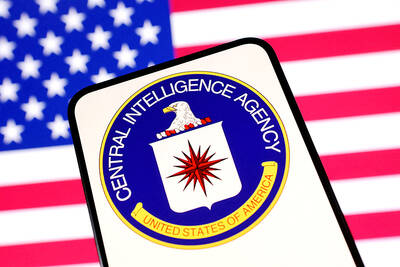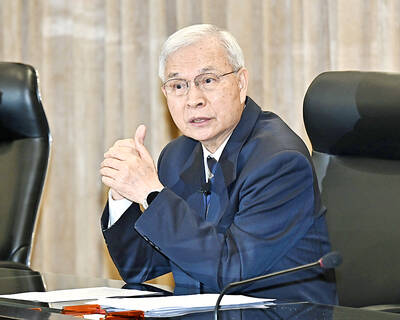China’s massive military modernization program is dominated by preparations for a conflict with Taiwan and the possibility of US intervention, a Pentagon report said on Friday.
The report, which was issued in Washington, said that Beijing is ready to conduct missile attacks and precision strikes against the nation’s air defense systems, air bases, radar sites, missile silos, space assets and communications facilities.
All of this in an attempt to “degrade Taiwan’s defenses, neutralize Taiwan’s leadership or break the public’s will to fight.”

Photo: Reuters
In its annual report to the US Congress on China’s military and security developments over the previous year, the Pentagon said Beijing continues to pursue a long-term, comprehensive military modernization program designed to improve its armed forces capacity to fight short-duration, high-intensity regional conflicts.
“Preparing for potential conflict in the Taiwan Strait remains the focus and primary driver of China’s military investment,” it said.
The report added: “China is increasing its emphasis on preparations for contingencies other than Taiwan, such as contingencies in the East China Sea and South China Sea.”
According to the report, China’s strategy incorporates persuasion and coercion to deter or repress moves toward Taiwanese independence.
Despite a warming in cross-strait relations during the administration of President Ma Ying-jeou (馬英九), “there have been no signs that China’s military posture opposite Taiwan has changed significantly,” it said.
The report said that the People’s Liberation Army (PLA) has developed and deployed military capabilities to coerce Taiwan or to attempt an invasion if necessary.
It said that China appears to be prepared to defer the use of force as long as it believes that unification remains possible in the long term and the costs of conflict outweigh the benefits.
If the decision is made to use force against Taiwan, the report said that China might first signal its readiness and then build up a force “to optimize the speed of engagement over strategic deception.”
Another option would be for China to sacrifice overt, large-scale preparations in favor of surprise to force rapid military and political resolution before other countries could respond, it said, adding that maritime and air blockades are also a possibility.
“China might use a variety of disruptive, punitive or lethal military actions in a limited campaign against Taiwan, likely in conjunction with overt and clandestine economic and political activities,” the report said.
It added: “Such a campaign could include computer network or limited kinetic attacks against Taiwan’s political, military and economic infrastructure to induce fear in Taiwan and degrade the populace’s confidence in the Taiwan leadership.”
“Similarly, PLA special operations forces could infiltrate Taiwan and conduct attacks against infrastructure or leadership targets,” it said.
The report said that the PLA is capable — with few overt preparations — of launching an invasion of small Taiwan-held islands in the South China Sea, such as the Pratas Islands (Dongsha Islands, 東沙群島) or Itu Aba Island (Taiping Island, 太平島).
A PLA invasion of medium-sized, better defended outlying islands such as Matsu or Kinmen is within its capabilities, but would risk galvanizing pro-independence sentiment and generating international opposition.
Large-scale amphibious invasion of Taiwan proper would involve “significant political and military risk” and the report indicates that scenario is unlikely.
Nevertheless, the report says that the PLA Air Force has stationed a large number of advanced aircraft within range of Taiwan, providing them with significant capability to conduct air superiority and ground attack operations.
At the same time, China’s long-range air defense systems provide “a strong layer of defense against a counterattack.”

The CIA has a message for Chinese government officials worried about their place in Chinese President Xi Jinping’s (習近平) government: Come work with us. The agency released two Mandarin-language videos on social media on Thursday inviting disgruntled officials to contact the CIA. The recruitment videos posted on YouTube and X racked up more than 5 million views combined in their first day. The outreach comes as CIA Director John Ratcliffe has vowed to boost the agency’s use of intelligence from human sources and its focus on China, which has recently targeted US officials with its own espionage operations. The videos are “aimed at

STEADFAST FRIEND: The bills encourage increased Taiwan-US engagement and address China’s distortion of UN Resolution 2758 to isolate Taiwan internationally The Presidential Office yesterday thanked the US House of Representatives for unanimously passing two Taiwan-related bills highlighting its solid support for Taiwan’s democracy and global participation, and for deepening bilateral relations. One of the bills, the Taiwan Assurance Implementation Act, requires the US Department of State to periodically review its guidelines for engagement with Taiwan, and report to the US Congress on the guidelines and plans to lift self-imposed limitations on US-Taiwan engagement. The other bill is the Taiwan International Solidarity Act, which clarifies that UN Resolution 2758 does not address the issue of the representation of Taiwan or its people in

US Indo-Pacific Commander Admiral Samuel Paparo on Friday expressed concern over the rate at which China is diversifying its military exercises, the Financial Times (FT) reported on Saturday. “The rates of change on the depth and breadth of their exercises is the one non-linear effect that I’ve seen in the last year that wakes me up at night or keeps me up at night,” Paparo was quoted by FT as saying while attending the annual Sedona Forum at the McCain Institute in Arizona. Paparo also expressed concern over the speed with which China was expanding its military. While the US

SHIFT: Taiwan’s better-than-expected first-quarter GDP and signs of weakness in the US have driven global capital back to emerging markets, the central bank head said The central bank yesterday blamed market speculation for the steep rise in the local currency, and urged exporters and financial institutions to stay calm and stop panic sell-offs to avoid hurting their own profitability. The nation’s top monetary policymaker said that it would step in, if necessary, to maintain order and stability in the foreign exchange market. The remarks came as the NT dollar yesterday closed up NT$0.919 to NT$30.145 against the US dollar in Taipei trading, after rising as high as NT$29.59 in intraday trading. The local currency has surged 5.85 percent against the greenback over the past two sessions, central